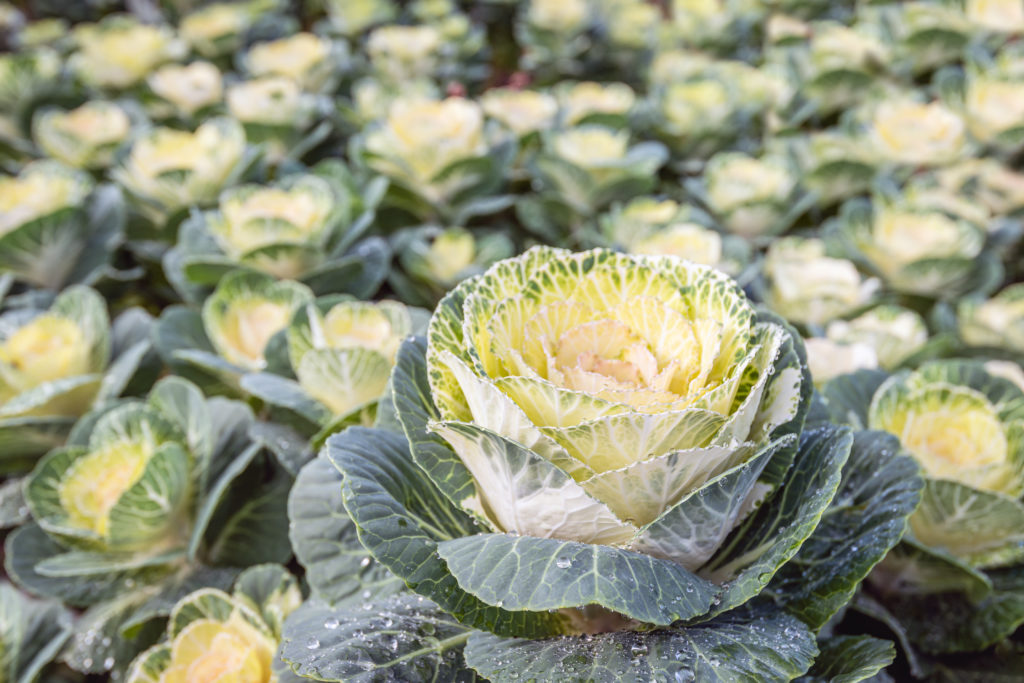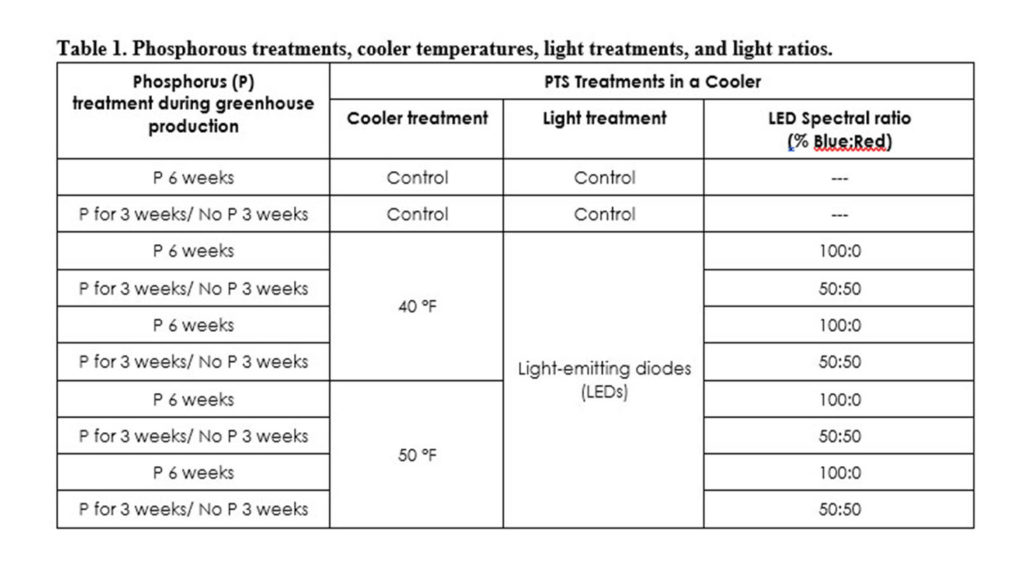Enhancing Foliage Color of Ornamental Cabbage and Kale with Prior-to-Shipping Light and Temperature Treatments in Coolers
Authors: Annika Kohler1, Cathy Whitman1, Garrett Owen1, Brian Whipker2, and Roberto Lopez1
Michigan State University1 and North Carolina State University2
Introduction
Ornamental flowering cabbage and kale (Brassica oleracea var. acephala) is a bedding plant that is typically produced outdoors in the late summer and early fall. It is popular due to its vibrant and intense purple, white, and pink foliage colors that are attributed to anthocyanin pigments. For most crops, anthocyanin synthesis is induced by light quality and intensity and, to a lesser extent, by cultural and environmental factors such as low temperatures, nutrient stress, and pathogens.

For cabbage and kale the coloration of the foliage is often expressed in the early fall as night temperatures begin to fall below 55 °F. Therefore, 3 to 5 weeks of cool night temperatures are required for the plants to accumulate anthocyanin pigments and establish foliage color. This coloration requirement by wholesale buyers poses a challenge with crop scheduling; as anthocyanins are not always fully accumulated and expressed in time for shipment. For example, during the fall of 2017, warm temperatures in mid-September prevented growers from shipping their crops due to poor coloration. Our previous research has determined that prior-to-shipping (PTS) supplemental lighting with LEDs providing blue (B) and red (R) light can enhance anthocyanin production in red leaf lettuce and purple fountain grass in as little as 3 and 7 days, respectively. Thus, many growers have expressed interest in determining whether PTS cooling in combination with LEDs in a cooler will quickly initiate leaf coloration. Additionally, research at NC State University has determined that low to no phosphorus fertilization can also lead to enhanced pigmentation.
Objective
To determine if phosphorus restriction for half of outdoor or greenhouse production in combination with a short duration PTS cooling and B:R light-emitting diode (LED) sole-source lighting treatment in coolers will enhance foliage color of ornamental cabbage and kale. Specifically, the goals of this study are to: 1) evaluate the effect of phosphorus restriction; 2) quantify the effects of short duration PTS cooling temperatures and 3) light quality (red and blue light) treatments in a cooler.

Materials and Methods
Rooted plugs of cabbage ‘Osaka Red’ and kale ‘Glamour Red’ and ‘Nagoya White’ were transplanted into quart pots on 03 and 17 Aug. 2018. The plants were placed in a glass-glazed greenhouse under a natural day length with a day/night air temperature set point of 75/60 ºF. The plant growth regulator paclobutrazol was applied weekly as a substrate drench at a rate of 1 to 2 ppm. On 24 Aug. and 07 Sept., 60 plants of each cultivar were divided into two different phosphorus fertilizer treatments. Treatment 1 received (ppm): 125 nitrogen (N), 12 phosphorus (P), and 125 potassium (K) during the entire 6 week production cycle, while treatment 2 received (ppm): 125 N, 12 P, and 125 K for 3 weeks followed by 125 N, 0 P, and 125 K for 3 weeks. On 14 and 28 Sept., 40 plants of each cultivar and phosphorous treatment were transferred into two separate walk-in coolers and placed under sole-source LED treatments with light ratios (%) of 100:0 B:R or 50:50 B:R (P.L. Light Systems’ HortiLED MULTI) at either 40 ºF or 50 ºF for 12 days (See Table 1). Ten plants of each cultivar and phosphorus treatment remained in the greenhouse (control).
Results
Coloration
After 3 days of PTS LED sole-source lighting in a cooler under a light ratio (%) of 50:50 B:R at 40 ºF, ornamental kale ‘Nagoya White’ and ‘Glamour Red’ began to show a change in foliage color (center leaves). As time under this treatment combination progressed to 14 days, the coloration also progressed. Plants that were in this treatment combination and received P restriction during the last 3 weeks of production also had more coloration that those that received 12 ppm P during the entire production cycle.
Plants under LEDs providing a light ratio (%) of 100:0 B:R and in a cooler with a temperature set point of 50 ºF were generally slower to transition in color than those under a light ratio (%) of 50:50 B:R and in a cooler with a temperature set point of 40 ºF.
Ornamental cabbage ‘Osaka Red’ did not respond to the treatments while in the cooler. However, upon transplant in the garden, those plants under PTS LED sole-source lighting under a light ratio (%) of 50:50 B:R at 40 ºF showed significant color after 7 days.
Conclusions
The minimum duration for PTS cooler LED lighting (50:50 B:R) and temperature (40 ºF) treatments appears to be 5 and 7 days (Figure 2 and 3) for ‘Nagoya White’ and ‘Glamour Red’, respectively. However, we recommend at least 10 days for both cultivars to ensure that all the center leaves have transitioned (Figure 1).
 Figure 1. Kale ‘Nagoya White’, cabbage ‘Osaka Red’, and kale ‘Glamour Red’ (Left to Right) received either 12 ppm phosphorous (P) for 6 weeks or P restriction (0 ppm) for the last three weeks. Plants were then placed in coolers to receive prior-to-shipping (PTS) sole-source LED treatments with light ratios (%) of 100:0 blue (B):red (R) or 50:50 B:R at either 40 ºF or 50 ºF for up to 14 days.
Figure 1. Kale ‘Nagoya White’, cabbage ‘Osaka Red’, and kale ‘Glamour Red’ (Left to Right) received either 12 ppm phosphorous (P) for 6 weeks or P restriction (0 ppm) for the last three weeks. Plants were then placed in coolers to receive prior-to-shipping (PTS) sole-source LED treatments with light ratios (%) of 100:0 blue (B):red (R) or 50:50 B:R at either 40 ºF or 50 ºF for up to 14 days.

Figure 2. Kale ‘Nagoya White’ received either 12 ppm phosphorous (P) for 6 weeks (entire production cycle) or P restriction (0 ppm) for the last three weeks. Plants were then placed in coolers to receive 5 days of prior-to-shipping (PTS) sole-source LED treatments with light ratios (%) of 100:0 blue (B):red (R) or 50:50 B:R at either 40 ºF or 50 ºF.
 Figure 3. Kale ‘Glamour Red’ received either 12 ppm phosphorous (P) for 6 weeks (entire production cycle) or P restriction (0 ppm) for the last three weeks. Plants were then placed in coolers to receive 5 days of prior-to-shipping (PTS) sole-source LED treatments with light ratios (%) of 100:0 blue (B):red (R) or 50:50 B:R at either 40 ºF or 50 ºF.
Figure 3. Kale ‘Glamour Red’ received either 12 ppm phosphorous (P) for 6 weeks (entire production cycle) or P restriction (0 ppm) for the last three weeks. Plants were then placed in coolers to receive 5 days of prior-to-shipping (PTS) sole-source LED treatments with light ratios (%) of 100:0 blue (B):red (R) or 50:50 B:R at either 40 ºF or 50 ºF.
Acknowledgments
We thank P.L. Light Systems, the Western Michigan Greenhouse Association, and the Metro Detroit Flower Growers Association for funding and Mast Young Plants for the donation of plant material.
 Author: Roberto Lopez is an assistant professor with the Department of Horticulture at Michigan State University. His area of expertise is Controlled environment specialty crop production; Lighting applications for greenhouses and indoor vertical production; light-emitting diodes; and young plant propagation.
Author: Roberto Lopez is an assistant professor with the Department of Horticulture at Michigan State University. His area of expertise is Controlled environment specialty crop production; Lighting applications for greenhouses and indoor vertical production; light-emitting diodes; and young plant propagation.


